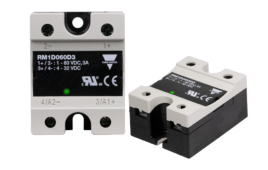By Lateef Uddin, Product Engineer, Drives and Motion Division of Yaskawa America, Waukegan, Ill
A key goal in our product development process is to use design and analysis tools to reduce the number of prototypes we must build and test during the concept design phase. These software tools help us determine the best designs for reducing and dissipating heat generated by electronic components. The thermal analysis tools validate thermal designs before building prototypes, and in some cases, eliminate the need to prototype.
The ability to predict thermal performance in early stages of the product design process helps reduce the number of prototypes, which reduces product life cycle time and cost. We evaluate thermal performances of our drive modules, inverter and rectifier modules, filters, custom designed cabinets, and other components and assemblies.
We use ANSYS Icepak PC-based software to evaluate the thermal performance of our electronic systems in a range of applications including heat sink optimization, simulation of air flow in enclosures, analysis of temperature distribution on insulated gate bipolar transistors (IGBTs), and optimization of electronics packaging.
ANSYS Icepak uses the ANSYS Fluent computational fluid dynamics (CFD) solver. The solver analyzes fluid flow and includes all modes of heat transfer for both steady state and transient thermal-flow simulations.
As there is constant pressure to reduce package dimensions but maintain high power requirements of components and assemblies, efficient thermal design is challenging. Due to the complexity of these electronics systems, accurate and detailed prediction of thermal performance is required to determine the best design.
For thermal analysis of our drive modules, optimal IGBT heat dissipation design is essential. These IGBTs are mounted on heat sinks which dissipate their heat.
IGBT layout on the heat sink and design of the heat sink itself are affect thermal performance. A detailed analysis of different layouts helps select the best layout.
Once the layout is determined, we perform multiple simulations to optimize the heat sink for given boundary conditions. Optimization includes the fin size, fin pitch, base thickness, fan standoff distance, and other factors. One of the main goals of thermal simulations in this case is to check if the operating temperature of the IGBTs is within the limiting temperature specified by the manufacturer.


These plots show IGBT surface temperatures when the fin thickness is changed from 2 mm and 3 mm with all other parameters being
constant. Increasing the fin thickness by 1 mm reduces the heat sink surface temperature from approximately 113° C to approximately 109° C.
Along similar lines, the thermal design challenges of inverter and rectifier modules is linked to their internal structure. These modules are comprised of several IGBTs and diodes interconnected in parallel to assure the required high current ratings. The modules are mounted in close proximity inside a common housing or package.
The modules are mounted using a conducting substrate on the heat sink which is cooled with external fans. After using analysis tools to design the heat sinks for best thermal performance, other thermal design parameters are studied using simulations.
For example, the best positioning of the thermocouples on the heat sink surface can be determined through simulations. Correct positioning of the thermocouples helps to avoid module overheating should the heat sink fan fail.


These plots show the temperature on the heat sink surface during normal fan operation and five minutes after fan failure. The fan failure causes a rapid rise in temperature and could lead to component failure if not promptly addressed.
A transient thermal analysis simulates the fan failure condition, which helps us determing the heat flow pattern on the heat sink surface. Thermocouples are then positioned based on the heat flow pattern. The heat flow pattern can also be animated to look at the real-time heat flow pattern, which may not be possible with physical testing.
Lab testing products to determine thermal performance is expensive, so repeated testing for varying electronics system designs is not generally feasible. However, with software simulation models of products, variations among different designs can be easily evaluated for thermal performance by modifying the parameters in the model.
Simulation helps predict the impact of higher ambient temperatures, higher current ratings, and other factors. ANSYS Icepak simulations help us achieve optimal thermal performance in our electronics systems. Detailed thermal simulations performed on systems have only 5% temperature variation compared to the actual testing, validating our confidence in the simulation process. The end result is a reduced number of prototypes and tests, along with a decrease in time for product development and the cost of prototypes by approximately 20%.
Yaskawa America
www.yaskawa.com
::Design World::
Filed Under: Software • 3D CAD, Software • FEA, Software • simulation, ENGINEERING SOFTWARE, ELECTRONICS • ELECTRICAL





Tell Us What You Think!